RECOVERING UKRAINE'S
LOST STEPPE
Activities
|
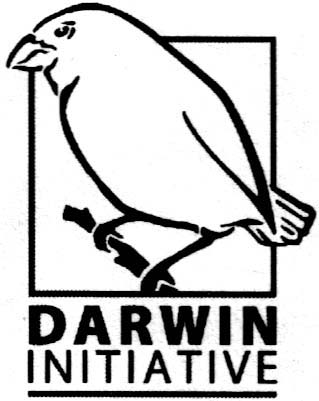
|
General, Nature Conservation on Defence Estates, Opuk Nature Reserve, Potential new Site of Special Scientific Interest in Donetsk Oblast, Seed Banks, Sustainable Tourism, Ukrainian Steppe Nature Reserve, XIV Congress of European Mycologists
GENERAL
A book on steppe conservation was produced: Збереження Степів України [Conservation of Steppes of Ukraine]. Гелюта, В.П.; Ткаченко, В.С.; Вакаренко, Л.П.; Войтюк, Ю.О.; Генов, А.П.; Мосякін, С.Л. [Heluta, V.P.; Tkachenko, V.S.; Vakarenko, L.P.; Boityuk, Yu.O.; Genov, A.P.; Mosyakin, S.L.] [eds]. 164 pp., 2002. [Ukrainian, with English abstracts of each chapter] Академперіодика [Akademperiodika], Київ [Kiev] ISBN 966-8002-52-0.
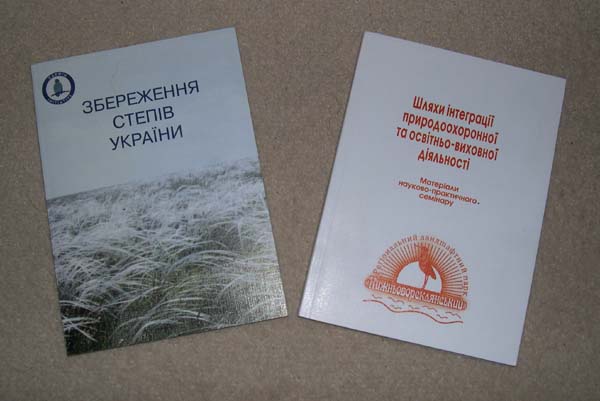
Two books on steppe conservation published through this project
|
|
A seminar on the theory and practice of integrating nature conservation and education, supported by this project, was held in Poltava oblast from 1-3 July 2004 at the A.P. Karishin Biological Station of the Lower Vorskla River Regional Landscape Park. Papers were presented about the project's work on steppe conservation and seed bank development, and proceedings were published as a book: Шляхи Інтеграції Природоохоронноїта Освітньо-Виховної Діяльності [Pathways of Integration of Nature Conservation and Education]. Байрак, О.М. [Bairak, O.M.] [ed.].143 pp. [Ukrainian] Верстка [Verskla Printers] Полтава [Poltava].
|
NATURE CONSERVATION ON DEFENCE ESTATES
This work was carried out in Kiev. Contact was established with the Department of Ecological & Radiation Safety, Deputy Chief, Department of NBC Protection Troops, General Staff of Ukrainian Armed Forces, and preliminary informal meetings were made with leading to agreements on priorities and plans for a Ukrainian military delegation to visit the UK; UK Ministry of Defence [MOD] conservation literature was distributed to military readership in Ukraine and 24 other countries through the British Council's English for Peacekeepers scheme.
Meetings. By late September 2004 at least fifteen meetings (varying from formal sessions and seminars to informal meetings) had been held with representatives from the General Staff of the Ukrainian Armed Forces and Ukraine’s National Institute of Strategic Research.
UK study tours for Ukrainian military.
2003. From 11 to 18 May 2003 a group of four Ukrainians made a study trip to the UK with the prime objective of seeing examples of conservation on military land. Thanks to superb efforts by the UK MOD, the group visited the following sites: Salisbury Plain Training Area, Defence Estates Headquarters Farnham, Porton Down, a former Atomic Weapons Establishment Site in Cardiff, and the Sennybridge Training Area. To emphasize constructive re-use of redundant military sites, the group also visited the historic ships and the Royal Armories Museum, Fort Nelson (Portsmouth), and HMS Belfast.
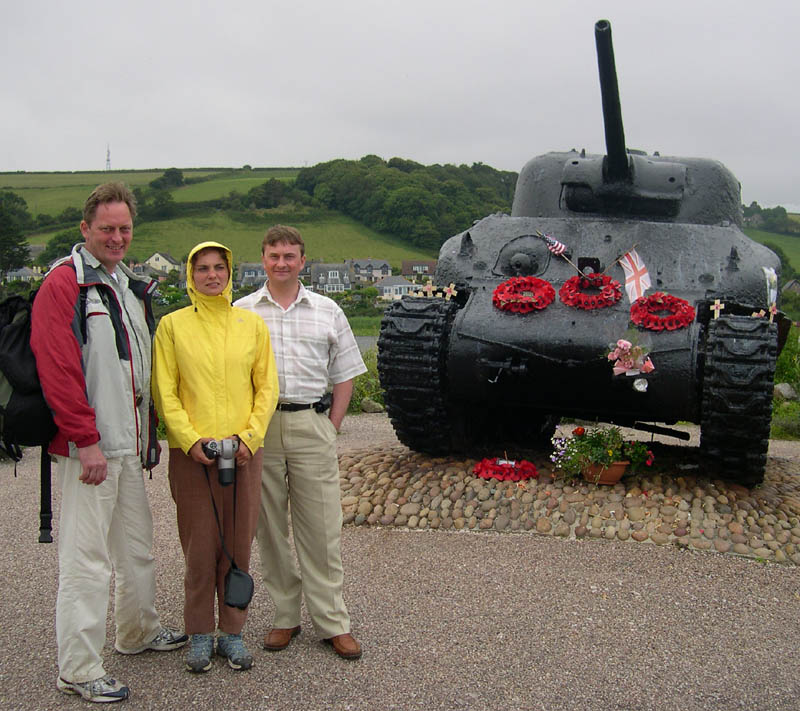
Ukrainian visitors in front of an American tank at the Slapton war memorial in south Devon
|
|
2004. From 12 to 19 July 2004 a group of three Ukrainians made a further study trip to the UK with the prime objective of participating in the Eurosite Workshop 85 Management of Military Sites & Nature Conservation in Europe, on Salisbury Plain and Porton Down, organized as part of the Salisbury Plain Life Project. The workshop was attended by participants from North America and many western European countries. Ukrainian participants made a presentation about the state of nature conservation and environmental questions on Ukrainian military sites, and gained valuable contacts and insights into techniques used in western European and North American countries. To understand access from the point of view of the general public, the group also visited the Dartmoor and Lulworth Training Areas and sections of the Southwest Coast Path informally, as though tourists.
|
Seminars. The project participated in a major seminar Current Issues in Military Ecology organized by the Ukrainian MOD National Scientific Research Centre of Defence Technologies and Military Safety of Ukraine on 16-17 October 2003 making two presentations published (in Ukrainian) in its proceedings (Hayova, V.P. & Kovalevsky, V.V. "Some aspects of the British system of military ecological safety", pp. 65-66; Kryvomaz, T.I. "British experience of developing ecological safety on military training areas", pp. 64-65). The project plans to participate in a similar seminar in October 2004.
Military Exhibitions. The project provided a stand (on the theme of the rôle of Ukraine’s military in nature conservation, highlighting collaboration through the Darwin Initiative project) at Protection Technologies 2003, an international exhibition held in Kiev in 22-24 October 2003, and visited by very many people. The project plans to participate in a similar exhibition in October 2004.
|
|
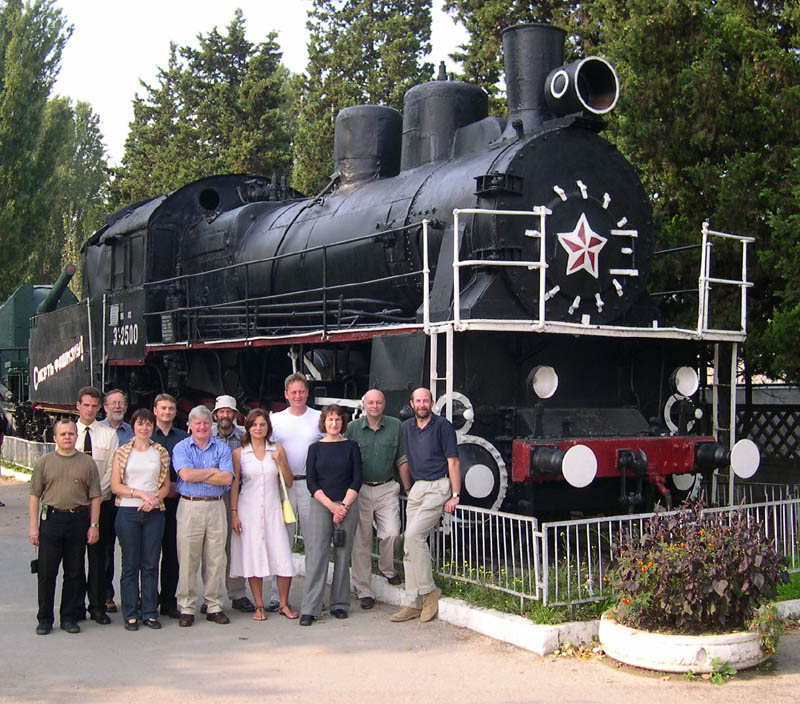
Sebastopol'. The British visitors and their hosts in front of an historic military locomotive
|
Visit to Ukraine by British Experts in Military Environmental Questions. From 20 to 27 September 2004, a party of five British experts in military environmental questions from the UK MOD's Defence Estates visited Ukraine to deliver seminars and to view two Ukrainian military training areas with the purpose of discussing environmental questions relating to those sites with their Ukrainian hosts. The party comprised experts in management of military training areas, management of military training, and decontamination of former military sites, together with a military ecologist and military archaeologist. Seminars were held in Kiev and Sebastopol', and the party furthermore visited military training areas near Pereyaslav Khmel'nitskyi (Kiev oblast') and Zarechnoe (in Crimea). This year, being the 150th anniversary of the Battle of Balaclava, the party also visited Crimean War battlefield sites and the town of Balaclava itself.
Environmental Monitoring of Sites. Following discussion with local Commandants, provisional agreement has been reached to permit Ukrainian undergraduate and postgraduate students under supervision to start the work of recording base line data about biodiversity on two training areas. During summer 2004, the first field visits by students were made to one of those training areas. Plans are in hand to apply jointly for funds to develop this environmental monitoring and to prepare an integrated land management plan for one training area.
Advisory Panel. There is now agreement to invite key institutions and NGOs to send representatives to a formulation workshop at which establishment of a formal Advisory Panel will be considered.
|
|
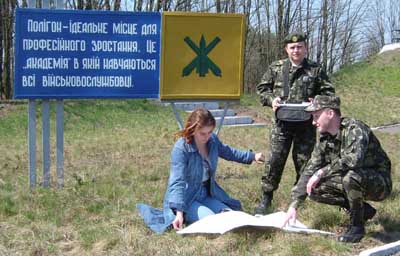
Discussing biodiversity monitoring with officers at one Ukrainian military training area
[photo T.I. Krivomaz]
|
OPUK NATURE RESERVE
Work on the reserve
2002-2003. Wells were restored with tests to ensure potable water quality, and are now functioning; drinking troughs (for animals), stone bowls (for humans), and the pipes supplying the reserve fire-fighting water tank were repaired; more than 5 tons of rubbish was removed from the reserve; a small building to shelter reserve staff and store equipment in a remote part of the reserve was repaired; a shelter for visitors near one well was repaired; field plots were established for monitoring, restoration and evaluation of treatments; villagers and local students were involved in the work; material for the proposed visitors' centre began to be collected; reserve leaflets and posters were prepared and printed; seeds of rare steppe plants were collected.
2003-2004. 12 km of an anti-fire belt around the reserve was ploughed with participation of the Vityaz Collective Farm, and anti-fire equipment was purchased. Two new barriers to control access to the reserve by motor vehicles were set up together with about 150 concrete posts marking the border of the reserve, and an information board was set up on the reserve. Further work was also carried out clearing rubbish from the reserve, particularly on and near the beach, and around the wells and springs: a further 5 tons of rubbish was cleared by local people including "Green Patrol" students, taking the total removed through the project to 10 tons. Work continued during the second year of the project on the 28 monitoring experimental plots set up on the reserve (now marked by posts and boards), where a programme of biological monitoring is under way, and on the steppe plots outside, but adjacent or very close to the reserve, designated for experiments on steppe restoration. Of note are the plots for control of Hyoscyamus niger [black henbane, a noxious weed related to deadly-nightshade] (quarter 6) and Elytrigia repens [couch grass, a common weed] (quarter 8). Plans have been made for two nature trails (one long - 15 km, the other short - 10 km), including projected routes and descriptions of the areas crossed; at the time of writing work has begun constructing the trails (marking, grass cutting, viewpoints, rest-places etc.). A website for the reserve is also being prepared.
Local Involvement. To keep local people informed and encourage their involvement, a noticeboard is being constructed near the reserve office, where information, announcements, collecting proposals and other aspects of the project's work will be posted. 3 small public workshops were held in the reserve during autumn 2003 and winter 2003-2004 about the role of the reserve and about participation of local people in nature protection.
Other people involved. Delegates of the XIV Congress of European Mycologists (from 10 European countries and the USA) visited the reserve to study its fungi. This opportunity was used to obtain opinions from external and independent experts on various problems relating to steppe protection. An agreement was also reached on organization of practical ecological work in the reserve by students of Donetsk National University, Kryvyi Rih Teachers' Training University and the Tauric National University, and a programme for student work is now being developed.
The reserve building at Opuk
A suitable building was identified, agreement was reached to use part of it as a visitors' centre, and plans were made for its restoration; Work on repairing the building designated as a visitors’ centre at that reserve has taken longer than originally anticipated, but goes well. Many roofing timbers have been replaced, and the whole building has been completely re-roofed, the outside walls repaired with new rendering and whitewashing where appropriate, and the chimney re-pointed. The entrance steps have been fully repaired, with a new concrete surround to the building, and the area around the building has been greened. At the end of September 2003 the building’s window-frames, windows, door-frames, doors and interior were still in need of much work planned for spring 2004 (during winter the village is often cut-off). Work began again in late March and renovation of the interior has progressed rapidly, with repair and replacement of windows, window-frames, doors and door-frames, installation of suspended ceilings, and improved interior walls with new plastering and fibreboard. By the end of September 2004, the room for the museum and the visitors' accommodation were ready for use, and work was progressing in setting up the museum's exhibition. Visitors' Centre exhibits. Ten cabinets have been prepared for biological and other exhibits. Collection of materials for exhibiting have been made with the help of local people. 25 poster-sized photographic prints have also been prepared for the exhibition.
SEED BANKS
2003. Up to the end of 2003, work was been carried out mainly in Crimea, in Nikita and Karadag. Seed gathering. By the end of the 2003 season, Dr Isikov had gathered seeds of 35 species of steppe plants from a range of locations in southern and eastern Crimea. Initially that seed was stored partly by Dr Isikov, and partly at the “Raduga” medicinal plants farm. Steppe plant seeds were sown experimentally at the "Raduga" medicinal plants farm. New Seed Banks established. Dr Tykhonenko and Dr Isikov have established seed banks in Nikita and (provisionally) Karadag (like Opuk, Karadag is a reserve in eastern Crimea, but it is more accessible and with a better infrastructure). Establishment has included facilities for storing the seeds and their associated voucher (herbarium) specimens. Equipment for collecting, drying, preserving and storing seeds (including cold storage) has also been purchased. The 2003 seed collections are now stored in these banks. Databases established. Dr Tykhonenko set up databases to store seed bank information, with the capability of producing labels. 150 species of steppe plants were identified as priorities for seed collection, and information about seed characteristics of around 100 of those species has already been computerized. Manual and collecting forms. Dr Tykhonenko located and visited about 50 internet sites dealing with seed banks and, using examples derived from those sites together with literature from the Kew Millennium Seed Bank, prepared and translated into Ukrainian instructions for collecting and preservation, and devised custom forms to fill in for each collection. Planning of work for 2004 and beyond. As a result of experience gained in 2003, Dr Tykhonenko planned much more extensive seed collecting for 2004, employing university students, and planned a two-day workshop in Kiev in February 2004 to prepare 4 selected prospective student assistants. Plans were also made to grow wild steppe plants locally near Opuk Reserve, and sites and local people suitable for this were identified.
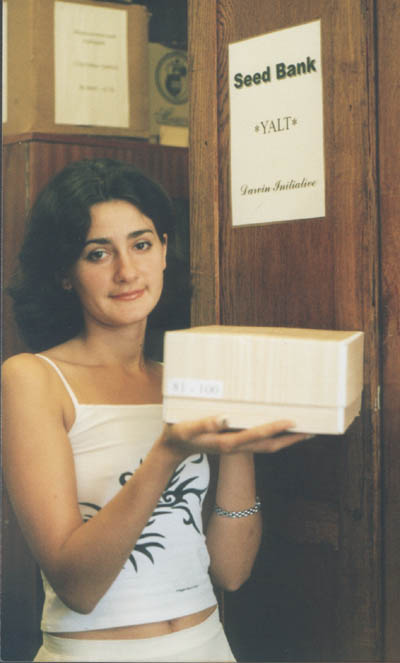
The Seed Bank at Nikita in Crimea
[photo V.P. Isikov]
|
|
2004. Dr Tykhonenko ran his workshop in Kiev training seed collectors. During the 2004 season, collecting continued in Crimea, and seeds were also gathered from locations near Kiev and Poltava. Seed gathering. By the end of the 2004 season, Dr Isikov and his assistants, some trained by Dr Tykhonenko's workshop in Kiev, had gathered seeds of more than 150 species of steppe plants from a range of locations in southern and eastern Crimea, augmenting the Nikita and Karadag seed banks. Near Kiev, Dr Tykhonenko and his assistants had also gathered seeds of around 50 species of plants, mostly different from those collected in Crimea by Dr Isikov. Furthermore, In Poltava, Dr O.M. Bairak and colleagues collected around 20 further species. The total number of species in the three banks (Karadag, Kiev and Nikita) probably now exceeds 200. Website. A new website describing these seed banks and providing information in Ukrainian about collecting seeds has been established. Planning of work for 2005 and beyond. A refridgerator is now being purchased for the Kiev Seed Bank, which it is hoped will then move to a more secure location within the M.G. Kholodny Institute of Botany. An enlarged website and an English language version are also planned. The possibility of establishing a further bank in eastern Ukraine is being considered
|
SUSTAINABLE TOURISM
Backpackers' hostel established in Balaclava. A suitable building for a backpackers' hostel in Balaclava, western Crimea, was identified, and the hostel was established partly with Darwin Initiative support. Ms Kryvomaz visited Balaclava (5-9 January 2004) to assess progress in this work. The hostel opened in spring 2004, and now has a website produced partly with support from this project.
Simple B&B style accommodation near Opuk. The village nearest Opuk Reserve has now begun to provide accommodation for visitors, and that accommodation has been used by senior project participants. The village and the adjacent reserve were also visited by mycologists from the XIV Congress of European Mycologists. The villagers are being helped with feedback from project senior participants in how to present their accommodation.
Possible buildings for backpackers' hostel identified near Opuk. Discussions with villagers revealed further possibilities for accommodation, specifically the possibility of purchasing a small property to set up a backpackers' hostel. Three properties in the village and another property on the coast to the east of the village were identified as potentially suitable. Again little progress was possible during the winter, and efforts have now been resumed to establish a small hostel within or near the village.
Participation in two British Council meetings on sustainable development. Dr Minter and Dr Hayova participated in two British Council meetings on sustainable development, one in Balaclava, the other in Kiev. Balaclava had been selected as a venue partly to showcase work done by Dr Hayova and Dr Isikov through the present project and a DFID Small Environmental Projects Scheme project. Dr Hayova was, furthermore, involved in the planning of the Balaclava meeting (Sustainable Development of Ukraine, 9-10 October 2003).
Further funding obtained. As a result of contacts established at those meetings, Dr Hayova, with assistance from Dr Minter, obtained further modest DEFRA funding to establish a Crimean South Coast Stakeholders Forum with additional work on setting up a small network of backpackers' hostels in Crimea, and preparing the way for a south Crimea coast path. That funding will now pick up much of the work on sustainable tourism started by the present project.
UKRAINIAN STEPPE NATURE RESERVE: KHOMUTOVSKI STEPPE
Conservation through grazing was strengthened so that the horse population (established by an earlier project) reached a sustainable level, and there is currently grazing by 15 horses helping to control scrub encroachment.

Two of the horses used to control scrub encroachment at Khomutovski Steppe
[photo V.P. Heluta]
|
|
2003 Saw the arrival of a new reserve director, and in October of that year Dr Heluta visited the reserve to appraise him of this project's work and to make a full assessment of how the grazing programme was progressing. During winter 2003-2004, Dr Heluta prepared a proposal to a special commission of the Presidium of Ukraine's National Academy of Sciences for support of this part of our work. 2004, early in the year, the very satisfactory result was announced that that the Academy had agreed fully to take over long-term funding of the grazing project, real recognition of the value of the work. Dr Heluta will continue to supervise the grazing work, but from now on under Academy support. A website for the Khomutovski Steppe reserve has been constructed through this project.
|
POTENTIAL NEW SITE OF SCIENTIFIC INTEREST IN DONETSK OBLAST
Supported by this project, negotiations are in progress to establish a new "zakaznik" (site of special scientific interest) of about 20 hectares of steppe in Donetsk oblast.
XIV CONGRESS OF EUROPEAN MYCOLOGISTS
In September 2003, supported by this project, the XIV Congress of European Mycologists was held in Katsiveli on the southern coast of Crimea. The Congress was attended by more than 150 participants from over 30 countries, and was notable for its decision to establish the European Mycological Association.







